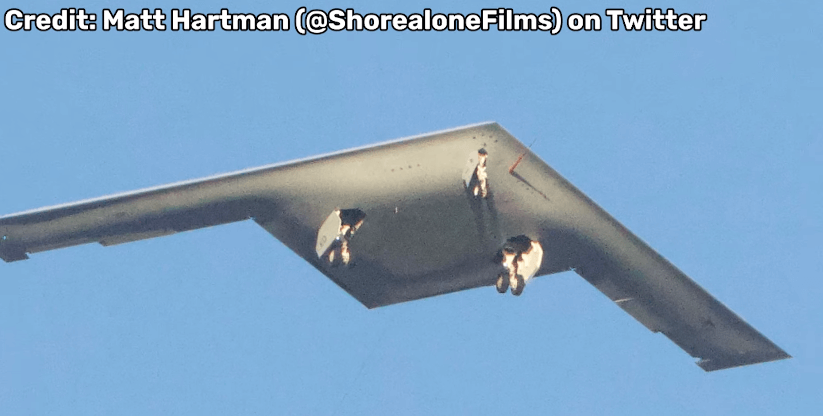B-21 RAIDER Made its First Flight.
Embark on an exciting journey into the future of military aviation with the B-21 Raider.
This cutting-edge stealth bomber is more than an aircraft; it’s a symbol of innovation, strategic planning, and the evolution of aerial capabilities.
Read More: F-16 Fighter Jet
10 Facts of B-21 Raider
let’s shed light on these 10 key aspects of the B-21 Raider:

Sixth Generation:
- The B-21 Raider is a state-of-the-art bomber classified as a sixth-generation aircraft, incorporating the latest advancements in technology, stealth, and mission capabilities.
- Stealth:
- Stealth is a cornerstone of the B-21 Raider’s design. It features advanced stealth technology, including reduced radar cross-section and infrared signature management, allowing it to operate covertly in contested environments.
- The backbone of the Fleet:
- The B-21 Raider is envisioned as a key component, or the “backbone,” of the future U.S. Air Force bomber fleet, playing a central role in strategic and tactical operations.
- A Digital Bomber:
- As a digital bomber, the B-21 Raider is equipped with cutting-edge avionics and digital systems, enhancing its precision, adaptability, and overall operational effectiveness.
- Cloud Technology:
- Cloud technology integration is part of the B-21 Raider’s advanced systems. This facilitates data storage, sharing, and processing, contributing to enhanced connectivity and information sharing.
- Open Architecture:
- The B-21 Raider is built on an open architecture design, allowing for flexibility and ease of integration with evolving technologies. This approach facilitates future upgrades and system enhancements.
- A National Team:
- The development and production of the B-21 Raider involve collaboration among various entities, often referred to as a “national team.” This includes government agencies, defense contractors, and industry partners.
- Sustainment:
- Sustainment refers to the long-term support and maintenance of the B-21 Raider throughout its operational life. Comprehensive sustainment strategies are crucial for ensuring the bomber’s continued effectiveness.
- Global Reach:
- The B-21 Raider is designed with a global reach, capable of conducting extended-range missions worldwide. Its operational range allows it to respond rapidly to emerging threats and strategic requirements.
- Raider:
- “Raider” is the designated name for the B-21 bomber, reflecting its role as a powerful and agile asset in the U.S. Air Force arsenal. The name emphasizes its stealthy and offensive capabilities.
These 10 facts collectively highlight the B-21 Raider’s status as a cutting-edge, versatile, and strategically significant aircraft within the U.S. Air Force’s future capabilities.
Read More: Havelsan Full Flight Simulator
Sustainment Data Migration to the Cloud for B-21 Raider: Enhancing Efficiency and Security
In the relentless pursuit of modernizing defense technologies, the B-21 Raider embarks on a pivotal journey with the migration of sustainment data to the cloud. This strategic move signifies a transformative shift in managing crucial information integral to the operational lifecycle of this next-generation bomber.

1. Introduction: Embracing Digital Transformation
The B-21 Raider’s sustainment data migration to the cloud represents a commitment to embracing digital transformation within the defense sector. This introduction sets the stage for the comprehensive advancements to be explored.
2. Scalability for Future Demands: Cloud Dynamics in Action
The integration of cloud technology brings unprecedented scalability to sustainment data. Explore how this dynamic scalability ensures that the B-21 Raider’s data infrastructure can adapt seamlessly to evolving demands without compromising operational efficiency.
3. Improved Accessibility: Anytime, Anywhere Maintenance
Discover how cloud-based solutions revolutionize accessibility, enabling authorized personnel, from maintenance crews to logistical support teams, to securely access critical sustainment data from anywhere. This newfound agility enhances decision-making processes and responsiveness to operational requirements.
4. Robust Security Measures: Safeguarding Sensitive Information
Delve into the advanced security measures offered by cloud platforms. Encryption protocols, access controls, and continuous monitoring work in tandem to fortify the protection of sensitive sustainment data, ensuring compliance with stringent security standards.
5. Alignment with Digital and Open Architecture Design: Future-Ready Foundations
Explore how the transition to cloud-based sustainment data management aligns seamlessly with the B-21 Raider’s digital and open architecture design. This alignment fosters an environment conducive to future upgrades, advancements, and the integration of emerging technologies.
6. Conclusion: Pioneering Digital Innovation in Defense
Conclude the narrative by emphasizing the strategic significance of the sustainment data migration to the cloud for the B-21 Raider. Highlight how this move positions the bomber at the forefront of digital innovation within the defense landscape, ensuring optimal performance, reliability, and adaptability throughout its operational tenure.
Read More: How Israel Chooses Targets for Airstrikes in Gaza?
Evolution of Stealth Bombers
- Stealth Pioneers: Discover the origins of stealth bombers, from the iconic B-2 Spirit to the cutting-edge technology that makes the B-21 Raider a formidable force.
- Strategic Advancements: Explore the advancements in stealth technology that have led to the creation of the B-21 Raider, reflecting the ever-changing landscape of modern warfare.
B-21 Raider Progressing Towards Flight Test: A Milestone in Development
The B-21 Raider, the herald of next-generation stealth bombers, continues its steadfast progression toward the highly anticipated flight test phase. This crucial milestone marks a significant step in the comprehensive development of this cutting-edge aircraft.
- Advancements in Development:
- The B-21 Raider’s journey to flight test underscores the culmination of extensive design, engineering, and testing efforts. This phase represents the synthesis of theoretical concepts into tangible aeronautical prowess.
- Critical Pre-Flight Evaluations:
- Preceding the flight test, the aircraft undergoes meticulous evaluations to ensure its structural integrity, aerodynamic efficiency, and adherence to performance metrics. These assessments are pivotal in validating the theoretical foundations of the design.
- Integration of Stealth Technologies:
- A focal point in the development is the seamless integration of advanced stealth technologies. The B-21 Raider aims to redefine stealth capabilities, allowing it to operate effectively in diverse and challenging operational environments.
- Strategic Implications:
- The progression to flight test holds strategic implications, signifying the aircraft’s readiness to demonstrate its capabilities in real-world scenarios. It marks a transition from conceptualization to tangible, in-the-air validation.
- Path to Operational Deployment:
- Successful flight tests pave the way for the B-21 Raider to move closer to operational deployment, where it will contribute to the modernization and potency of the United States Air Force’s bomber fleet.
As the B-21 Raider advances steadily toward flight tests, the aerospace community eagerly anticipates witnessing the tangible realization of this formidable stealth bomber’s capabilities, heralding a new era in military aviation.
Read More: Pakistan and Qatar Explore Opportunities to Enhance Defense Cooperation
The Birth of B-21 Raider
- Strategic Imperatives: Delve into the strategic decisions that prompted the development of the B-21 Raider, a program with a significant investment exceeding $97 billion.
- Timeline: Trace the exciting timeline of the B-21 Raider, from its announcement in 2016 to the meticulous planning and testing phases.
- Global Collaboration: Uncover the international collaborations that played a role in shaping the B-21 Raider, highlighting its status as a collaborative achievement.
B-21 Raider Specifications
- Stealth Design:
- Reduced Radar Cross-Section (RCS)
- Aerodynamic Innovations for Covert Operations
- Payload Flexibility:
- Capacity for Various Munitions
- Precision-Guided Missiles and Conventional Bombs
- Avionics:
- State-of-the-Art Navigation and Targeting System
- Propulsion Systems:
- Advanced Engines for Efficiency and Power
- Impressive Speeds and Ranges
- Infrared Signature Management:
- Reduced Infrared Signature for Stealth Operations
- Electronic Warfare Capabilities:
- Jamming and Countermeasure Systems
- Autonomous Capabilities:
- Integration of Autonomous Systems for Operational Efficiency
- Sustainable Operations:
- Consideration of Environmental Impact
- Balance Between Operational Power and Sustainability
Design and Features
- Stealth Design Elements: Uncover the sleek design elements that make the B-21 Raider virtually invisible to enemy radar, ensuring it can operate covertly in high-threat environments.
- Payload Flexibility: Learn about the adaptability of the B-21 Raider’s payload, allowing it to carry a variety of munitions for versatile mission requirements.
- Aerodynamic Innovations: Explore the aerodynamic innovations incorporated into the B-21 Raider, enhancing its maneuverability and overall performance.
Stealth Technology
- Reduced Radar Cross-Section (RCS): Understand how the B-21 Raider achieves its stealth capabilities through a reduced radar cross-section, making it less visible on enemy radar systems.
- Infrared Signature Management: Explore the technology behind managing the infrared signature of the B-21 Raider, making it a challenging target for adversaries.
- Jamming and Countermeasures: Delve into the electronic warfare capabilities of the B-21 Raider, including jamming and countermeasure systems that contribute to its survivability.
Strategic Importance
- Penetrating Enemy Defenses: Learn about the B-21 Raider’s primary role in penetrating sophisticated enemy air defenses, delivering precise strikes with its advanced avionics.
- Global Reach: Discover the impressive unrefueled range of over 6,000 nautical miles, allowing the B-21 Raider to conduct extended-range missions globally.
- Humanitarian Missions: Explore the potential applications of the B-21 Raider in humanitarian missions, showcasing its versatility beyond traditional military roles.
Comparison with Previous Bombers
- Advancements Over B-2 Spirit: Compare the B-21 Raider with its predecessor, the B-2 Spirit, highlighting the significant improvements in stealth, payload, and avionics.
- Operational Sustainability: Analyze the operational sustainability of the B-21 Raider, considering factors such as maintenance requirements and ease of integration with existing fleet capabilities.
B-21 Raider’s Maiden Flight: A Historic Milestone
In a momentous occasion for military aviation, the B-21 Raider made its first flight, marking a historic milestone in the development of this cutting-edge stealth bomber.
The inaugural flight, conducted with precision and expertise, showcased the culmination of years of planning, design, and engineering.
Read More: National Aerospace Science and Technology Park
Key Highlights of the Maiden Flight:
- Successful Takeoff: The B-21 Raider took to the skies in a flawless takeoff, demonstrating the efficiency of its advanced propulsion systems.
- In-Flight Maneuvers: Skilled pilots executed a series of in-flight maneuvers, emphasizing the agility and responsiveness of the B-21 Raider.
- Stealth Performance: During the maiden flight, the B-21 Raider exhibited its exceptional stealth performance, validating its ability to operate undetected in hostile environments.
Future Implications
- Adapting to Future Threats: Understand how the B-21 Raider’s modular design allows it to adapt to future threats through upgrades, ensuring it remains at the forefront of innovation.
- Strategic Deterrence: Explore how the B-21 Raider contributes to the United States’ nuclear triad, serving as a crucial element of strategic deterrence.
- Autonomous Capabilities: Delve into the potential integration of autonomous capabilities in future iterations of the B-21 Raider, reflecting the evolution of unmanned aerial systems.
Challenges and Controversies
- Budgetary Scrutiny: Examine the scrutiny faced by the ambitious B-21 Raider program, with critics questioning the substantial budget allocation in light of evolving warfare.
- Operational Secrecy: Delve into the debates surrounding the operational secrecy of the B-21 Raider, balancing classified information protection with public transparency.
- Environmental Impact: Consider the environmental concerns associated with the B-21 Raider’s operational footprint, addressing issues such as emissions and sustainable aviation practices.
The Future Unveiled: Sixth Generation Fighter Aircrafts of the United States
As the B-21 Raider takes center stage, the United States is already setting its sights on the future with the development of sixth-generation fighter aircraft. Positioned to succeed the existing fifth-generation fighters like the F-35 Lightning II, these cutting-edge aircraft represent the next frontier in aerial dominance.
Key Features of Upcoming Sixth Generation Fighters:
- Advanced Stealth Technology: The sixth-generation fighters will push the boundaries of stealth technology, ensuring unprecedented levels of invisibility on radar systems.
- Artificial Intelligence Integration: Embracing artificial intelligence, these fighters will feature advanced AI systems for enhanced situational awareness and decision-making capabilities.
In a paradigm shift, the upcoming sixth-generation fighters will incorporate directed energy weapons, including laser systems. These weapons provide pinpoint accuracy and rapid engagement capabilities, redefining air-to-air and air-to-ground warfare.
- Unparalleled Connectivity: Seamless communication and data-sharing capabilities will be a hallmark of these fighters, creating a networked battlefield where information is instantaneously relayed between aircraft and ground control.
- Supersonic Speeds: Building upon the supersonic capabilities of their predecessors, sixth-generation fighters aim to achieve even higher speeds, ensuring rapid response and the ability to cover vast distances in minimal time.
- Adaptive and Morphing Structures: These fighters will feature adaptive structures that can morph in flight, optimizing aerodynamics based on specific mission requirements. This innovation enhances agility and efficiency in varying combat scenarios.
Strategic Implications of Sixth-Generation Fighters:
- Air Dominance: The sixth-generation fighters signify the United States’ commitment to maintaining air dominance, outclassing potential adversaries through superior technology and capabilities.
- Multi-Domain Operations: Emphasizing multi-domain operations, these fighters are designed to operate seamlessly across air, land, sea, space, and cyberspace, providing a comprehensive and integrated approach to modern warfare.
- Deterrence and Security: The development of sixth-generation fighters reinforces the strategic deterrence capabilities of the United States, signaling a commitment to global security and stability.
International Collaborations and Competition:
- Global Partnerships: The development of sixth-generation fighters involves collaboration with international partners, fostering alliances, and sharing technological expertise to create a unified front in addressing evolving security challenges.
- Competitive Landscape: As the United States progresses in developing sixth-generation fighters, there is a keen awareness of the competitive landscape. Other nations are also investing in similar endeavors, intensifying the race for technological supremacy in the realm of aerial warfare.
Challenges and Future Outlook:
- Technological Hurdles: The development of sixth-generation fighters poses technological challenges, requiring innovative solutions to overcome obstacles related to propulsion, materials, and systems integration.
- Budgetary Considerations: As with any ambitious military program, the allocation of budgets and resources becomes a critical factor. Striking a balance between advancements and fiscal responsibility will be essential for the sustained development of these futuristic aircraft.
Conclusion: A Testament to Evolution
Wrap up the journey through the B-21 Raider, acknowledging its role as a testament to the continuous evolution of military technology. From stealth design to strategic importance, every aspect underscores its significance in shaping the future of aerial warfare. Sixth-generation fighters are in need of the future air warfare to the ever-evolving warfare landscape.
Note: The information above might not be accepted 100%. Please verify from your own sources. We will not be responsible for any kind of loss due to our content.
For more news, please visit Munafa Marketing.




